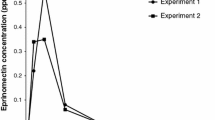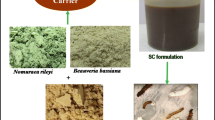Summary
Muscabac, aBacillus thuringiensis preparation containing exotoxin, was tested for its ability to control flies in latrines in a tropical environment.Chrysomyia sp. andEristalis sp., both species of medical importance, were the most common flies in the latrines. Both species were sensitive to treatment withB. thuringiensis. Reasonably good, lasting control was obtained in many latrines, but control was poor or partial in some, particularly those in which fresh faeces accumulated rapidly. A more frequent treatment with the bacteria would probably be more effective. An important result from a practical point of view was that the cell mass alone was at least as effective as the whole bacterial culture preparation (i.e. Muscabac) which contains the exotoxin. Microbiological examination showed that the bacterium grew well in many latrines, producing enough exotoxin to kill the fly larvae and give a long lasting control effect.
Résumé
Une préparation (Muscabac) deBacillus thuringiensis contenant l'exotoxine a été essayée pour son aptitude à contrôler les mouches dans des latrines en région tropicale.Chrysogenia sp. etEristalis sp., espèces d'importance médicale, sont les mouches les plus fréquentes dans ces latrines. Les deux espèces sont sensibles à un traitement parB. thuringiensis. Le plus souvent, on obtient ainsi un contrôle raisonnablement satisfaisant et durable, mais les résultats sont faibles ou partiels dans certains cas, notamment lorsque les fèces s'accumulent rapidement. Du point de vue pratique, un résultat important est que les cellules bactériennes seules sont au moins aussi efficaces que les préparations bactériennes totales contenant, comme le Muscabac, l'exotoxine. Les examens microbiologiques montrent que la bactérie se développe bien dans beaucoup de latrines et produit suffisamment de toxine pour tuer les larves de mouches et pour assurer un contrôle de longue durée.
Resumen
Se ha estudiado la capacidad del Muscabac, una preparación deBacillus thuringiensis que contiene una exotoxina, para controlar las poblaciones de moscas en las letrinas de ambientes tropicales. La moscas más comunes en las letrinas fueronChrysomyia sp. yEristalis, sp., ambas de interés sanitario. Las dos especies fueron sensibles al tratamiento conB. thuringiensis. En muchas letrinas se obtuvo un efecto remanente razonablemente bueno, pero en otras, el control fué malo o parcial, particularmente en aquellas letrinas en las que los excrementos recientes se acumulaban rápidamente. Un tratamiento bacteriano más frecuente probablemente sería más efectivo. Un resultado importante desde el punto de vista práctico fué que el tratamiento con la masa de células fué al menos tan efectivo como una preparación con el cultivo bacteriano completo (i.e. Muscabac) que contenía la exotoxina. El exámen microbiológico mostró que la bacteria creció bien en muchas letrinas produciendo toxina suficiente para matar a las larvas de mosca y manteniendo el efecto controlante durante largo tiempo.
Similar content being viewed by others
References
Carlberg, G. (1973) Biological effects of the thermostable exotoxin produced by different serotypes ofBacillus thuringiensis.Reports from Department of Microbiology, University of Helsinki,6, 1–90.
Fisher, R. & Rosner, L. (1959) Toxicology of the microbial insecticide, Thuricide.Journal of Agricultural and Food Chemistry,7, 686–688.
Holmberg, A., Sievänen, R. & Carlberg, G. (1980) Fermentation ofBacillus thuringiensis — a process analysis study.Biotechnology and Bioengineering,22, 1707–1724.
Kähkönen, M., Gripenberg, U., Carlberg, G., Meretoja, T. & Sorsa, M. (1979) Mutagenicity ofBacillus thuringiensis exotoxin III. Sister chromatid exchange in rats in vivo.Hereditas,91, 1–3.
Linnainmaa, K., Sorsa, M., Carlberg, G., Gripenberg, U. & Meretoja, T. (1977) Mutagenicity ofBacillus thuringiensis exotoxin. II. Submammalian tests.Hereditas,85, 113–122.
Meretoja, T. & Carlberg, G. (1977) The effectof Bacillus thuringiensis and of cell-free supernatants of some other bacteria on the mitotic activity of human lymphocytes.FEMS Microbiology Letters,2, 109–111.
Meretoja, T., Carlberg, G., Gripenberg, U., Linnainmaa, K. & Sorsa, M. (1977) Mutagenicity ofBacillus thuringiensis exotoxin I. Mammalian tests.Hereditas,85, 105–112.
Smirnoff, W. A. (1962) A staining method for differentiating spores, crystals and cells ofBacillus thuringiensis.Journal of Insect Pathology,4, 384–386.
Author information
Authors and Affiliations
Rights and permissions
About this article
Cite this article
Carlberg, G., Kihamia, C.M. & Minjas, J. Microbial control of flies in latrines in Dares Salaam with aBacillus thuringiensis (serotype 1) preparation, Muscabac. World J Microbiol Biotechnol 1, 33–44 (1985). https://doi.org/10.1007/BF01748152
Received:
Accepted:
Issue Date:
DOI: https://doi.org/10.1007/BF01748152




